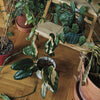Kokedama as living art

The name kokedama is derived from the Japanese words Koke = moss and Tama = ball. Instead of growing the plant in a pot, we grow it in a round ball of soil, which is still covered with moss and secured with string. Kokedama is actually a variant of bonsai . This method of growing plants is very aesthetic and actually economical. Also making kokedama itself is a calming and even meditative activity. We can hang the kokedama in the space or simply place it in a suitable container. Depending on which plant we choose for them, we can place the kokedama indoors or, for example, on a tree in the garden, in a summer sitting area or on a balcony. But one thing is certain, if you follow the following advice, it will bring you joy and attract admiring glances everywhere.

Photo: The most beautiful kokedamas look suspended, and if you choose an invisible suspension, e.g. nylon thread, from a distance they will look as if they are levitating in the air by themselves.
Which plant to choose for the kokedama?
Basically, any plant can be grown in a kokedama. In general, at least for beginners, it is better to work with a clayey, wetter substrate, which holds together better and does not crumble during production. He will appreciate moisture-loving plants - various ferns, marantha, syngonium. On the other hand, in the beginning, it is better to work with a smaller kokedama that fits in the hand, i.e. with a smaller plant, e.g. a small succulent. Which plant you choose depends primarily on where you want to place the kokedama. Always orient yourself according to the requirements of a specific plant species. You can make kokedama from the aforementioned ferns, tropical plants, succulents and cacti, but also from bulbs and tubers or from herbs or indoor plants. Don't be afraid to experiment.
What will you need?
It should be mentioned in advance that making a kokedama will not be without a mess. For example, prepare a tray on which you will work and a large bowl in which you will mix a suitable substrate. You will also need thread, synthetic/waxed string or perhaps shoe thread (it must not be made of materials that may break in constant contact with moisture), scissors, moss (preferably a large sheet of moss intended directly for the production of kokedam), peat moss, selected the plant and of course the substrate.
Photo: To prepare kokedama, we use our substrate and moss for wrapping
Which substrate to choose?
Opinions on the most suitable substrate differ, because it all depends on the choice of plant. In essence, it is enough to mix peat substrate and clay for bonsai. But if you want to play more with the substrate, and thus arrange a suitable home for the plant for several years, you can add pieces of coconut husk and perlite (to aerate the substrate), coconut fiber, akadam or water crystals (to retain water in the substrate, which is especially appreciated by hygrophilous plants), compost or slowly dissolving fertilizer (for essential nutrients). In order for the substrate to hold together well, special Japanese Ketotsuchi clay is also added.
We prepare kokedama in our own substrate with perlite, which we mix with akadama , zeolite , Japanese clay and peat moss . If you have trouble finding individual ingredients for a special substrate for kokedams, you can use a ready-made substrate , which we have also proven with moss, and thus save time.
Photo: Preparing the kokedama Chamaedorea Elegans , we are currently forming a ball
Wrapping the roots
There are several ways to complete a kokedama. We present several of them here, choose the one you like the most.
Take the plant out of the pot and gently remove the original substrate from the roots. It will go better if the plant has been left without water for several days and the substrate is dry. Then wrap the roots in a layer of peat, which you have previously soaked in water. This layer serves to ensure that the roots have a kind of barrier around them when you then press them together with the substrate into a ball.
Spread the pre-soaked moss sheet on the work surface, place the plant in the center and sprinkle the mixed substrate. Then wrap the root ball with moss and press to form a ball. Then tie it with waxed string. The string tends to loosen over time, so don't be afraid to tighten it enough .
Pour water into the mixed substrate to make a dough that can be formed into balls, but be careful not to create soggy mud. Then open the ball and place a plant in its center. Then tie everything together, wrap with moss and secure with string.
Or try to make a substance from the substrate and a small amount of water, which you will apply in small doses to the root ball of the plant and gradually enlarge and shape into a ball, which you will then wrap with moss and string.

Photo: Kokedama with Monstera Minima plant
Caring for a kokedama
You need to water the kokedama as often as required by the specific type of plant chosen. The best way to find out is to give the kokedama a hard time. Just place the kokedama in a bowl or bucket of standing water and let it soak. Be careful to water kokedamas with standing water and avoid chlorine, which is harmful to kokedamas, we recommend the same for misting. Depending on the size and dryness of the bale, approx. 10-30 minutes is sufficient. Once the kokedama is sufficiently soaked, take it out, let it drain on a saucer or plate, and then just place it in its original place. Don't worry, after draining, the water will not flow from it. Materials such as peat moss, zeolite and akadama retain moisture well and absorb water.
Between individual waterings, you can mist the bale, or even the entire plant. During the growing season, you can add fertilizer to the watering. For kokedam, we recommend using a liquid fertilizer or a crystalline fertilizer soluble in water.

Photo: Wrapped moss bale of thread
Since kokedams are made from natural materials, you have to accept that over time the natural work of fungi and microorganisms will show and its surface can become spotted, gray and unsightly. This often happens even with the new kokedama you have just created, it is a natural process because micro-organisms are often present in the moss itself, which wakes up the moment it gets wet. You only need to carefully remove them mechanically, they will disappear over time. Alternatively, you can loosen the original string, add some fresh substrate and wrap the kokedama again with new moss, but that's more for picky people who want to play with kokedamas :)
And what about the lifespan of the kokedam? In most cases, kokedams will last you several years. Usually after 5 years they need to be repaired and enlarged due to growing roots.
On behalf of the whole team of Dej me maid, I wish you a pleasant production and a lot of growing success!
Author: Ing. Elizabeth Lacinová
-
Posted in
Péče o pokojovky






